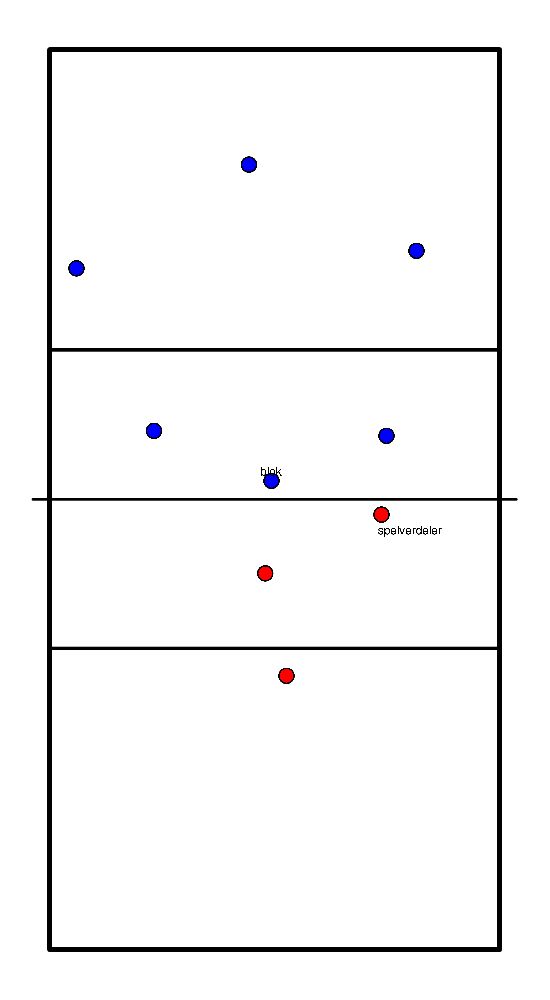Volleyball drills for technique attack / smash / spike / hitting
Attacking corners - empty ball pit
- Rest ensures ball safety
Centres attack - ball pit empty
- Rest ensures ball safety
Opposite attacks - empty ball pit
- Rest ensures ball safety
- 4 gives setup on 1 and 1 attacks on 2.
- 2 defends to 3,
- 3 gives setup on 2 and 2 attacks on 1,
- 1 defends on 4 and it starts all over again.
- After 3 and 4 have given 5 setups they switch,
- the challenge is to do this while keeping the ball in play.
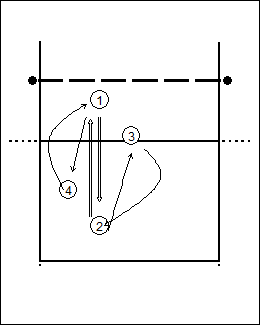
- Hang up the net at about 1,50 m.
- Work with 4 players, 2 on each side of the net.
- Player smashes the ball down, pass to player at the net
Batting with a fixed distributor, we pay attention to our run-up.
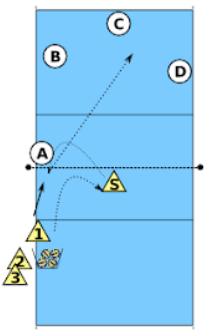
The attackers get the assignment to score directly with their attack. The defence of course gets the assignment to prevent this.
The game is played with a fixed distributor. A number of attackers stand at one side of the playing field with a ball. They play the ball to the distributor, who gives a setup for the attacker to attack.
If the attacker scores, he goes back to the back of the line of attackers (as a reward). If the attacker does not score, he must defend. For that purpose, the following sequence is used: Attacker - A - B - C - D - Attacker.
At the defense A is the blocker.
Discuss clearly in advance what immediate scoring means: ball on the ground or also if there is no playable defense.
Required:
- fixed playmaker s
- row of attackers with ball plays ball to sv
- Set-up to attacker 1
- If attack scores, to the back of the row of attackers.
- Otherwise attacker 1 to A - B - C- D- attacker
- In defence: A = blocker, BCD= at the back
In this exercise, the attackers are instructed to score directly with their attack. The defence of course gets the assignment to prevent this.
The game is played with a fixed distributor. A number of attackers stand at one side of the playing field with a ball. They play the ball to the distributor, who gives a setup for the attacker to attack.
If the attacker scores, he goes back to the back of the line of attackers (as a reward). If the attacker does not score, he must defend. For that purpose, the following sequence is used: Attacker - A - B - C - D - Attacker.
At the defense A is the blocker.
Discuss clearly in advance what immediate scoring means: ball on the ground or also if there is no playable defense.
Required:
- fixed playmaker s
- row of attackers with ball plays ball to sv
- Set-up to attacker 1
- If attack scores, to the back of the row of attackers.
- Otherwise attacker 1 to A - B - C- D- attacker
- In defence: A = blocker, BCD= at the back
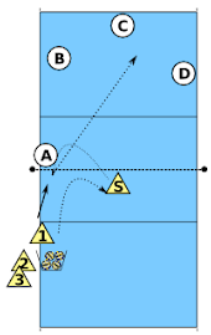
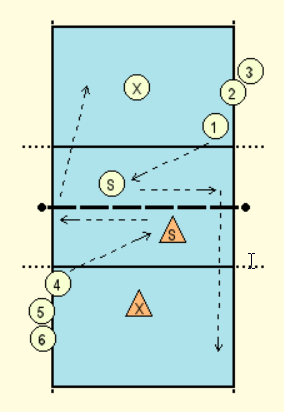
The purpose of the exercise is twofold: the defender must learn to 'read' where the attacker is going to hit and the attacker must look where the defence is before hitting.
We work with two regular playmakers, on both sides of the field a row of attackers on the left-for position. And two defenders, who may choose where they position themselves on the field. A defender has to defend the attack 10 times, preferably a nice pass, but touching is enough. If the attacker hits the net or leaves the field, that also counts. And the attackers may only smash, no prick balls! After the attack, the attacker retrieves the ball and joins the other row. The attacker who defends the ball at the 10th time takes the place of the defender. The defender will then of course attack.
Necessary:
- 8 - 10 players
- enough balls
If there are less players, the exercise can also be done, but then on one side. The attacker retrieves the ball and joins the same line.
The blocker joins in, indicates where he is going to block and the mid-back goes to his place.
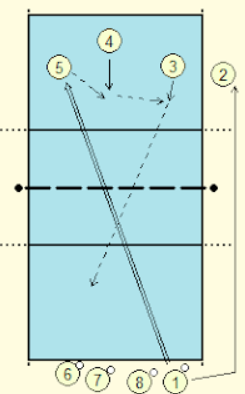
Three players line up to pass (numbers 3, 4 and 5). Player 2 stands ready at the side of the same court. The other players are ready with ball to serve on the other side.
- Player 1 serves the ball (and then runs straight to where player 2 is already standing).
- A player passes the ball to the server on position 2/3. The server gives a setup. And the third player plays the ball over the net.
- When the ball is over the net, the players turn: 2 enters the field (where 3 stood before) 3 goes to mid-back, 4 goes to the spot of 5 and 5 goes the serving spot of the other half.
- Then the next player can serve, on the drawing this is player 8. Etc.
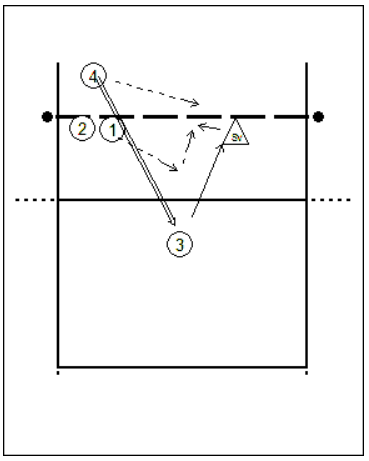
4 calmly attacks on 3 over the block of 1 and 2 - 3 passes to SV - 1 turns after block and attacks through middle - 4 blocks - 2 and 3 attack cover. Variant: idem on the left ; idem the right
- 1 and 2 hold the net - C plays ball in back field - 1 defends on 2 - 2 sets up on 1 - 1 hits to left or right back - 3 and 4 the next
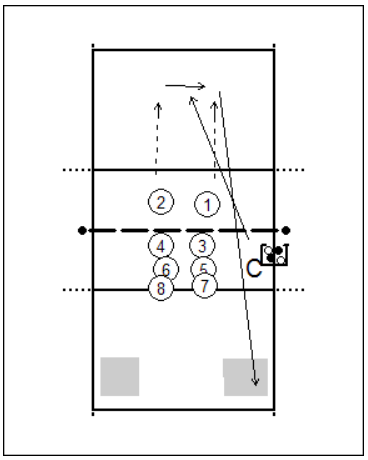
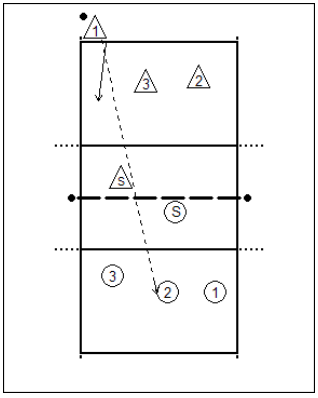 -
-
1 raise, pass to S- S set-up at 3 meter on one of the passers
- idem other side
- rally
- serve from the side where the ball hits the ground
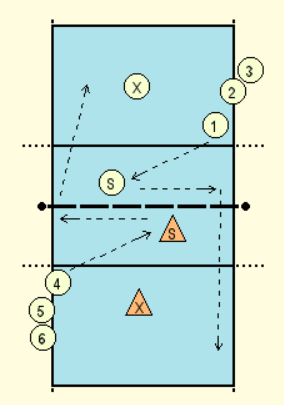
- The goal of the exercise is twofold: the defender must learn to 'read' where the attacker is going to hit and the attacker must look where the defence is before hitting.
- We work with two regular playmakers, on both sides of the field a row of attackers on the left-for position.
- And two defenders, who may choose where they position themselves on the field.
- A defender has to defend the attack 10 times, preferably a nice pass, but touching is enough.
- If the attacker hits the net or leaves the field, that also counts.
- And the attackers may only smash, no prick balls!
- After the attack, the attacker retrieves the ball and joins the other row.
- The attacker who defends the ball at the 10th time takes the place of the defender.
- The defender will then of course attack.
Necessary:
- 8 - 10 players
- enough balls
If there are less players, the exercise can also be done, but then on one side. The attacker retrieves the ball and joins the same line.
The blocker joins in, indicates where he is going to block and the mid-back goes to his place.
- 3 people at the net. (left, centre, right)
- 2 3 people at the back.
- On the other side 1 playmaker
- The rest is going to attack.
- Tim plays the balls.
- They attack the middle.
- The center on the other side of the block.
- The front left and right get behind the block to defend.
- The people in the back also defend on their position.
- After 2 minutes the players change.
